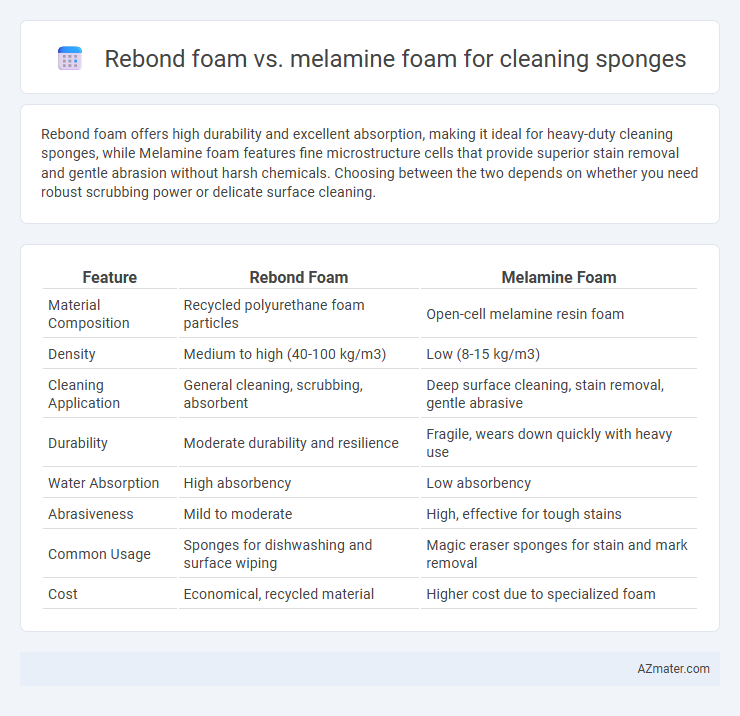Rebond foam offers high durability and excellent absorption, making it ideal for heavy-duty cleaning sponges, while Melamine foam features fine microstructure cells that provide superior stain removal and gentle abrasion without harsh chemicals. Choosing between the two depends on whether you need robust scrubbing power or delicate surface cleaning.
Table of Comparison
| Feature | Rebond Foam | Melamine Foam |
|---|---|---|
| Material Composition | Recycled polyurethane foam particles | Open-cell melamine resin foam |
| Density | Medium to high (40-100 kg/m3) | Low (8-15 kg/m3) |
| Cleaning Application | General cleaning, scrubbing, absorbent | Deep surface cleaning, stain removal, gentle abrasive |
| Durability | Moderate durability and resilience | Fragile, wears down quickly with heavy use |
| Water Absorption | High absorbency | Low absorbency |
| Abrasiveness | Mild to moderate | High, effective for tough stains |
| Common Usage | Sponges for dishwashing and surface wiping | Magic eraser sponges for stain and mark removal |
| Cost | Economical, recycled material | Higher cost due to specialized foam |
Introduction to Cleaning Sponges: Rebond Foam vs Melamine Foam
Rebond foam and melamine foam are two popular materials used in cleaning sponges, each offering distinct advantages for various cleaning tasks. Rebond foam is made from recycled polyurethane foam scraps, providing durability and elasticity for heavy-duty scrubbing and absorption of liquids. Melamine foam, known for its microstructure and abrasive texture, excels at removing tough stains and dirt with minimal chemical use, making it ideal for fine surface cleaning and polishing.
Material Composition: What Is Rebond Foam?
Rebond foam is made from shredded polyurethane foam scraps that are bonded together using adhesives and pressure, creating a dense and durable material ideal for heavy-duty cleaning sponges. It offers excellent resilience and cushioning properties, allowing it to effectively scrub surfaces without breaking down quickly. Compared to melamine foam, which is composed of a rigid, microporous polymer ideal for fine cleaning, rebond foam excels in durability and abrasion resistance.
Material Composition: What Is Melamine Foam?
Melamine foam is a lightweight, porous material made from a thermosetting resin called melamine-formaldehyde, which forms a rigid, open-cell structure that provides excellent abrasive properties without harsh chemicals. In contrast, rebond foam consists of shredded foam scraps bonded together, offering a denser and more resilient texture ideal for cushion or padding but less effective in fine cleaning. Melamine foam's unique microstructure acts like ultra-fine sandpaper, making it highly effective for removing stains, dirt, and grime from delicate surfaces without scratching.
Cleaning Performance Comparison: Rebond vs Melamine
Rebond foam exhibits superior abrasion resistance and durability, making it highly effective for scrubbing tough stains and heavy-duty cleaning tasks. Melamine foam, with its micro-porous structure, excels in removing dirt and grime using only water, providing exceptional performance on delicate surfaces and for fine cleaning. While rebond foam is ideal for deep cleaning and longer-lasting use, melamine foam offers precision cleaning with minimal effort and no chemicals.
Durability and Lifespan of Rebond and Melamine Sponges
Rebond foam cleaning sponges exhibit higher durability due to their dense, polyurethane composition, making them resistant to tearing and deformation during heavy-duty scrubbing tasks. Melamine foam sponges, while effective at removing stains and grime with their microstructure, tend to have a shorter lifespan because the delicate network of melamine resin breaks down faster under abrasive conditions. For prolonged use, rebond foam sponges provide superior longevity, retaining their shape and cleaning efficiency longer than melamine foam alternatives.
Surface Compatibility: Where Each Sponge Excels
Rebond foam excels on rough and uneven surfaces such as brick, concrete, and automotive parts due to its dense, durable structure that resists wear and maintains scrubbing power. Melamine foam is highly effective on smooth, delicate surfaces like glass, painted walls, and countertops because its microstructure gently lifts dirt without scratching or damaging finishes. Choosing the right foam depends on matching the sponge's abrasive level to the surface hardness and sensitivity for optimal cleaning results.
Safety and Chemical Resistance: Rebond vs Melamine Foams
Rebond foam offers robust chemical resistance and is less likely to degrade when exposed to harsh cleaning agents, making it safer for use in environments with strong chemicals. Melamine foam, while effective for gentle cleaning, can break down or release particles when exposed to acidic or abrasive substances, posing potential safety concerns. Choosing rebond foam ensures a safer cleaning sponge option with higher durability against chemical exposure.
Eco-Friendliness and Sustainability Considerations
Rebond foam sponges are typically made from recycled polyurethane, making them a more eco-friendly choice due to their use of repurposed materials and lower landfill impact. Melamine foam, while effective for cleaning, is derived from synthetic resins and poses challenges in biodegradability and recycling processes. Opting for rebond foam enhances sustainability by supporting circular material use and reducing reliance on non-renewable resources in household cleaning products.
Cost Analysis: Price Comparison and Value
Rebond foam sponges generally offer a lower upfront cost compared to melamine foam, making them an economical choice for bulk cleaning needs. Melamine foam, despite its higher price per unit, delivers superior cleaning performance and durability, providing better long-term value through reduced replacement frequency. Evaluating the price per use highlights that melamine foam can be more cost-effective due to its efficiency in removing tough stains without harsh chemicals.
Which Cleaning Sponge Is Best for You?
Rebond foam cleaning sponges offer superior durability and high-density structure, making them ideal for heavy-duty scrubbing and long-lasting performance. Melamine foam sponges provide exceptional fine abrasion and stain removal, especially effective on delicate surfaces without causing scratches. Choosing the best cleaning sponge depends on your cleaning tasks: rebond foam suits tough grime and repeated use, while melamine foam excels in gentle, precise cleaning and stain lifting.

Infographic: Rebond foam vs Melamine foam for Cleaning sponge
 azmater.com
azmater.com